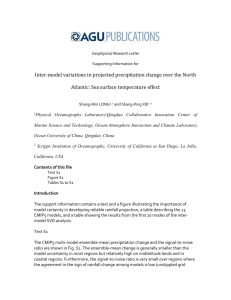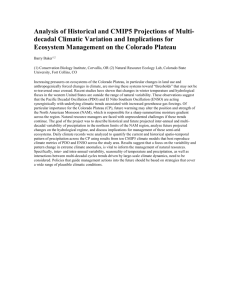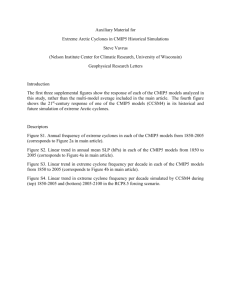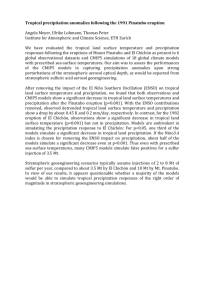grl29734-sup-0005-txts01
advertisement
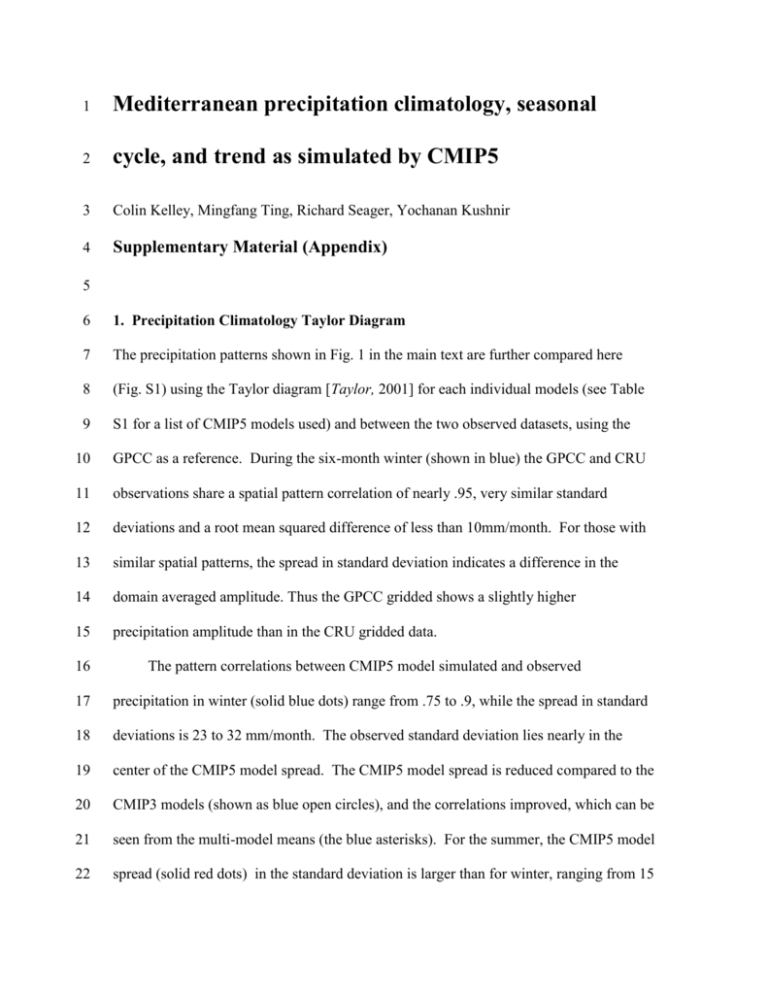
1 Mediterranean precipitation climatology, seasonal 2 cycle, and trend as simulated by CMIP5 3 Colin Kelley, Mingfang Ting, Richard Seager, Yochanan Kushnir 4 Supplementary Material (Appendix) 5 6 1. Precipitation Climatology Taylor Diagram 7 The precipitation patterns shown in Fig. 1 in the main text are further compared here 8 (Fig. S1) using the Taylor diagram [Taylor, 2001] for each individual models (see Table 9 S1 for a list of CMIP5 models used) and between the two observed datasets, using the 10 GPCC as a reference. During the six-month winter (shown in blue) the GPCC and CRU 11 observations share a spatial pattern correlation of nearly .95, very similar standard 12 deviations and a root mean squared difference of less than 10mm/month. For those with 13 similar spatial patterns, the spread in standard deviation indicates a difference in the 14 domain averaged amplitude. Thus the GPCC gridded shows a slightly higher 15 precipitation amplitude than in the CRU gridded data. 16 The pattern correlations between CMIP5 model simulated and observed 17 precipitation in winter (solid blue dots) range from .75 to .9, while the spread in standard 18 deviations is 23 to 32 mm/month. The observed standard deviation lies nearly in the 19 center of the CMIP5 model spread. The CMIP5 model spread is reduced compared to the 20 CMIP3 models (shown as blue open circles), and the correlations improved, which can be 21 seen from the multi-model means (the blue asterisks). For the summer, the CMIP5 model 22 spread (solid red dots) in the standard deviation is larger than for winter, ranging from 15 23 to 32 mm/month, but the pattern correlations are slightly higher. As with winter the 24 CMIP5 correlations have improved over CMIP3, however there is little improvements in 25 reducing the summer model spread in CMIP5 compared to CMIP3. While the 26 multimodel mean CMIP5 has reduced RMSD and higher pattern correlation compared to 27 that of CMIP3 in both summer and winter, the models substantially underestimate the 28 standard deviation of the observed precipitation in summer due largely to the 29 underestimate of the precipitation amplitude. This underestimation is likely due to 30 precipitation patterns north of 45N, as Fig. 2 indicates that CMIP5 models slighly 31 overestimate the Mediterranean region precipitation. Figure S1 indicates a modest but 32 significant improvement of the precipitation spatial patterns and amplitude simulated in 33 CMIP5 models over that in CMIP3. 34 35 36 2. Externally forced trend To better compare the externally forced portion of the total trends between models 37 and observations, we apply signal-to-noise (S/N) maximization EOF to obtain a winter 38 and summer signal representing the forced precipitation response. The S/N maximizing 39 EOF analysis is used to remove any residual “noise” left in the multimodel mean. We 40 use the preindustrial control runs, for the same models that were used to compose the 41 multimodel mean, to represent the noise. The time mean for each preindustrial model run 42 is removed first, and a pooled covariance matrix is created with each model’s time series 43 connected end to end. We use the first 104 years of the preindustrial run for each model 44 (see Kelley et al., 2011 for a more thorough discussion of the S/N maximizing EOF 45 technique). The analysis is applied to Mediterranean precipitation for the six-month 46 winter and summer over the domain shown in Fig. 1 from 1900-2004. A 10-year low 47 pass Butterworth filter was applied to the model output prior to any analysis for the 48 purpose of focusing on decadal and longer time scale variability. The S/N EOF for 49 winter and summer are shown in Figure S2 in spatial patterns (EOFs) and time series 50 (PCs) of the leading mode. For winter the signal indicates a zonal band of drying with 51 wetting poleward, for positive values of the time series, with the zero lines near 45 52 degrees north. A robust center of winter drying occurs in the eastern Mediterranean 53 basin, along the Mediterranean Sea coastline of Turkey, and the multimodel mean trend 54 pattern (Fig. 3), agrees quite well. The time series indicates little change before 1970, 55 after which the signal begins to steadily increase. In summer the band of drying shifts 56 poleward, with the strongest centers over land, particularly Portugal and northern Turkey, 57 which again agrees with the multimodel mean trend in Fig.3. In this case however, there 58 is a difference in sign over the Alps between the signal and multimodel mean trend 59 patterns. The signal pattern indicates much stronger precipitation change over southern 60 Europe relative to northern Europe. The pattern is also less zonally symmetric than for 61 winter, notably so north of the Black Sea. Unlike the winter time series the summer 62 signal increases linearly throughout the century. 63 After regressing the GPCC observations since 1900 onto the signal timeseries, we 64 reconstruct the externally forced field by multiplying the regression coefficients by the 65 signal timeseries [Kelley et al., 2011), 66 Pr*(x,y,t) = a(x,y) * PC1(t), 67 where Pr*(x,y,t) is the reconstructed precipitation from S/N PC1 and a(x,y) is the 68 regression coefficients between observed precipitation Pr(x,y,t) and PC1(t) at each grid 69 point. The externally forced trend is then obtained by least-square fit on the 70 reconstructed precipitation time series at each grid point, Pr*(x,y,t) from 1950-2004, and 71 is shown in the middle panels of Fig.3. 72 73 References: 74 Kelley, C., M. Ting, R. Seager and Y. Kushnir (2011), The relative contributions of 75 radiative forcing and internal climate variability to the late 20th Century winter drying of 76 the Mediterranean region. Climate Dyn., 38(9-10): 2001-2015. doi: 10.1007/s00382-011- 77 1221-z 78 Taylor, Karl E. (2001), Summarizing multiple aspects of model performance in single 79 diagram, J. Geophys. Res., 106, D7, 7183--7192, 2001. 80 81 Supplemental Table S1: CMIP5 models used in this study, horizontal resolution, number of 82 runs and modeling groups. Horizontal # historical runs resolution used MODEL (lon x lat) Modeling center bcc-csm1-1 2.81x2.81 3 Beijing Climate Center CanESM2 2.81x2.81 5 Canadian Centre for Climate Modeling and Analysis CCSM4 1.25x.94 6 National Center for Atmospheric Research CNRM-CM5 1.41x1.41 8 Centre National de Recherches Meteorologiques CSIRO-Mk3-6-0 1.88x1.88 10 Commonwealth Scientific and Industrial Research Organisation GFDL-CM3 2.5x2 3 Geophysical Fluid Dynamics Laboratory GFDL-ESM2G 2.5x2 3 Geophysical Fluid Dynamics Laboratory GFDL-ESM2M 2x2.5 1 Geophysical Fluid Dynamics Laboratory GISS-E2-H 2.5x2 5/5 (two phys) Goddard Institute for Space Studies GISS-E2-R 2.5x2 6/5/5 (three phys) Goddard Institute for Space Studies HadCM3 3.75x2.5 10 Met Office Hadley Centre HadGEM2-CC 1.88x1.25 1 Met Office Hadley Centre HadGEM2-ES 1.88x1.25 4 Met Office Hadley Centre inmcm4 2x1.5 1 Institute for Numerical Mathematics IPSL-CM5A-LR 3.75x1.89 5 Institut Pierre-Simon Laplace IPSL-CM5A-MR 2.5x1.27 1 Institut Pierre-Simon Laplace MIROC-ESM 2.81x2.81 3 Model for Interdisciplinary Research on Climate, Univ. of Tokyo MIROC-ESM-CHEM 2.81x2.81 1 Model for Interdisciplinary Research on Climate, Univ. of Tokyo MIROC-4h .56x.56 3 Model for Interdisciplinary Research on Climate, Univ. of Tokyo MIROC-5 1.41x1.41 4 Model for Interdisciplinary Research on Climate, Univ. of Tokyo 83 MPI-ESM-LR 1.88x1.88 3 Max Planck Institut MRI-CGCM3 1.13x1.13 3/2 (two phys) Meteorological Research Institute, Japan NorESM1-M 2.5x1.89 3 Norwegian Climate Centre 84 85 Fig. S1: Winter (Nov-Apr) and summer (May-Oct) Mediterranean (-10 to 50, 20 to 60) 86 precipitation climatology intercomparison, 1950-2004, in a Taylor Diagram. GPCC gridded 87 precipitation is used as a reference state. Blue dots are for the six-month winter (Nov-Apr) and 88 red for summer (May-Oct). Open circles are for CMIP3 and solid for CMIP5 models. The 89 asterisks are for observed and multi-model mean precipitation, as indicated on the plot. 90 91 92 93 Fig. S2: Signal-to-Noise Maximizing EOF spatial pattern (top) and PC1 time series (bottom) for 94 GPCC six-month winter (Nov-Apr) and summer (May-Oct) precipitation over the Great- 95 Mediterranean region as shown in Fig. 1. 96


